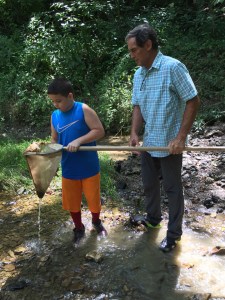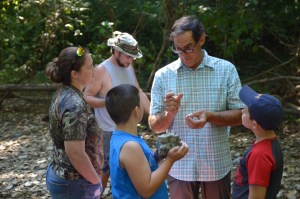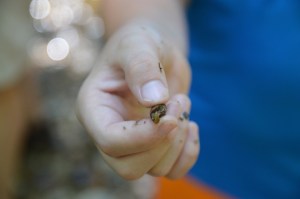Learning from ‘the Fork’ Educational creek walk at wildlife refuge teaches about pollution, pH and biology
Published 6:15 am Thursday, July 19, 2018

- Photo by Casey Craiger Education Director Rob Pendygraft (left) walks ahead of the group alongside Hayden Roessler (right).
On Wednesday, the Central Kentucky Wildlife Refuge hosted an educational “Creek Walk.”
The event, led by the refuge’s education directors Jim Roessler and Rob Pendygraft, took a group of Kentucky residents down to North Rolling Fork in Parksville.
Boyle County sits relatively high to surrounding areas, with the county’s lowest point sitting at 740 feet above sea level and North Rolling Fork sitting at 1,200 feet or more. The high elevation of the county means pollution that occurs flows into areas with a lower elevation.
Trending
“We’re trying to get everybody thinking downstream,” said Roessler.
Roessler told a firsthand encounter of creek pollution when he was younger: “Some people consider creeks as a dumping ground. I remember almost 40 years ago, when I was younger, our schools bus would stop and the driver would sweep the inside of the bus off at the bridge and into the creek.”
Although disappointed at the thought, Roessler said he recognizes that people were not as aware of the dangers of pollution then as compared to now.
Roessler discussed the many values of Carpenter Fork. The creek serves as a home to many ecosystems and sea creatures. During the two-and-a-half-hour venture, attendees of the event gathered numerous snails, caterpillars, butterflies, crayfish and beetles for observation. The creatures were released back to their habitat after being observed.
The search for wildlife sparked many questions from the group. One major fear was water moccasins, also known as western cottonmouths. Western cottonmouths are known for their venomous bite, and are often found in bodies of water. But Roessler quickly alleviated those worries — “We actually don’t have water moccasins here, just an occasional North American water snake,” he said. Northern water snakes are non-venomous, and are often kept as pets by reptile lovers.
Snakes should not be a deterrent from those wanting to visit the refuge or a creek, Roessler said.
Trending
“Rob and I were talking and the biggest thing you have to worry about here is rubbing against a limb and one of those fluffy caterpillars getting on you,” he said, laughing.
After the group felt comfortable getting in the water, several tests were run to assess the health of the stream. Roessler led the testing and kept track of results using a sheet provided by Water Watch, Kentucky’s volunteer water monitoring program.
The group began by testing the water temperature with thermometers.
“The temperature of the creek is very important. As the water temperature increases, the solubility of oxygen decreases,” said Roessler. The concentration of oxygen in a body of water is important to sustaining aquatic life.
Roessler then explained how chemical water tests are performed and explained the p
H scale to younger attendees.
“You see, it’s backwards from what you would think. The lower the number, the more acidic a substance,” he said. “Plant life in the water performs photosynthesis and the product of that process can affect acidity.”
“Limestone is a buffer and weakens acidity, raising pH,” Roessler explained. “That’s why it is used at coal-burning plants, to serve as a buffer against pollutants.”
Bethany Lawson attended the creek walk with her son Cainan. “That’s so interesting. Limestone has so many uses we never think of,” she said.
As the discussion became more complex, Roessler steered the discussion in a direction that would be understandable for the kids in his audience. He talked about the importance of collecting quality data when testing water. “Bad data is worse than no data,” he said. “Precision is also important. When we fill our containers with water we want to make sure we are measuring correctly. The key is to aim for baby bear’s porridge — just right.”
Several other biological and chemical tests were performed at the event. An electronic device was utilized to test the conductivity of the water. Analyzing the conductivity of water is important, as many species are sensitive to sudden changes in the salinity of their environment.
Another test using vials and an alkaline mixture tested the alkalinity of the water within the creek. Performing regular checks of alkalinity levels is important because if something changes the water’s pH level, alkaline serves as a buffer protecting the water and the life forms within it. This ability to neutralize acid is particularly important in Kentucky, due to the prevalence of acid rain in some areas, according to the education directors.
Following the discussion of water tests and their importance, Roessler concluded the event by passing nets to the younger members of the group and showing them how to effectively skim the water for organisms. Many children seized the opportunity to get knee-deep in the creek, to the simultaneous laughter and dismay of the parents.
Phil Corey brought his two sons Lane and Logan to the event. By the end of the event, the duo’s shirts were soaked with water.
“I’m glad you all had fun, but you’re going to have to ride home in the back of the truck,” Corey said, laughing.
SO YOU KNOW
The Central Kentucky Wildlife Refuge is a 500-plus-acre nature preserve located on Carpenter Creek Road off Ky. 37 in southwest Boyle County. CKWR is open to the public from dawn until dusk every day. There is no charge for admission. For more information visit ckwr.org.
- File photo by Casey Craiger The Central Kentucky Wildlife Refuge Creek Walk took place at North Rolling Fork located near the bridge on Carpenter Creek Road.
- Photo by Casey Craiger Lane Corey (left) is taught how to skim the creek by Jim Roessler (right).
- Photo by Casey Craiger Four Crayfish swim alongside various snails and a Hellgrammite. The sea creatures were found by the attendees of the Central Kentucky Wildlife Refuge Creek Walk.
- Photo by Casey Craiger A pulp snail rests in the hands of Lane Corey who found the creature in the creek. Education Director Jim Roessler noted that finding pulp snails in the creek is rare.
- Photo by Casey Craiger An American Dagger Moth Caterpillar crawls on rocks alongside the creek.
- Photo by Casey Craiger Dan (right) holds a PH measuring tool to the sunlight in order for he and Cainan Lawson (left) to view it more clearly.
- Photo by Casey Craiger Education Director Jim Roessler (center), sits on a rock while teaching (from left) Cainan Lawson, Lane Corey, Logan Corey, and Hayden Roessler how to test water alkalinity.















